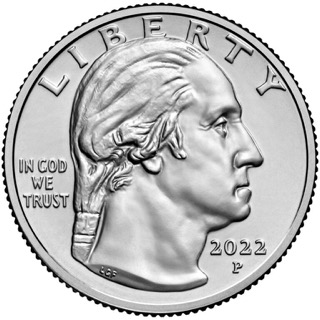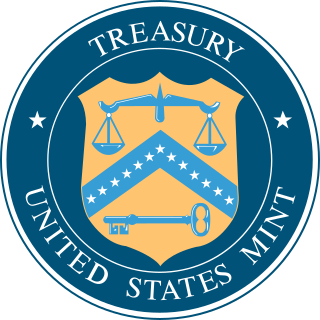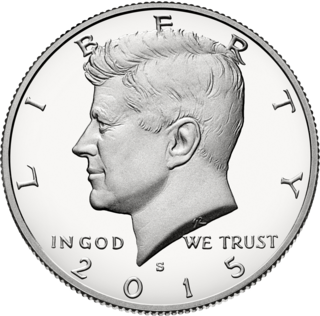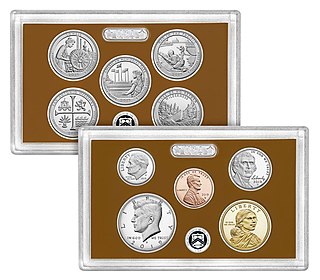
The quarter,short for quarter dollar,is a United States coin worth 25 cents,one-quarter of a dollar. The coin sports the profile of George Washington on its obverse,and after 1998 its reverse design has changed frequently. It has been produced on and off since 1796 and consistently since 1831.

The United States Mint is a bureau of the Department of the Treasury responsible for producing coinage for the United States to conduct its trade and commerce,as well as controlling the movement of bullion. It does not produce paper money;that responsibility belongs to the Bureau of Engraving and Printing. The first United States Mint was created in Philadelphia in 1792,and soon joined by other centers,whose coins were identified by their own mint marks. There are currently four active coin-producing mints:Philadelphia,Denver,San Francisco,and West Point.

The half dollar,sometimes referred to as the half for short or 50-cent piece,is a United States coin worth 50 cents,or one half of a dollar. In both size and weight,it is the largest United States circulating coin currently produced,being 1.205 inches in diameter and 0.085 in (2.16 mm) in thickness,and is twice the weight of the quarter. The coin's design has undergone a number of changes throughout its history. Since 1964,the half dollar depicts the profile of President John F. Kennedy on the obverse and the seal of the president of the United States on the reverse.
The dollar coin is a United States coin with a face value of one United States dollar. Dollar coins have been minted in the United States in gold,silver,and base metal versions. Dollar coins were first minted in the United States in 1794.

The Eisenhower dollar was a one-dollar coin issued by the United States Mint from 1971 to 1978;it was the first coin of that denomination issued by the Mint since the Peace dollar series ended in 1935. The coin depicts President Dwight D. Eisenhower on the obverse,and on the reverse a stylized image honoring the 1969 Apollo 11 Moon mission based on the mission patch designed by astronaut Michael Collins. Both sides were designed by Frank Gasparro. It is the only large-size U.S. dollar coin whose circulation strikes contained no silver.

The American Silver Eagle is the official silver bullion coin of the United States.

The Peace dollar is a United States dollar coin minted for circulation from 1921 to 1928 and in 1934 and 1935,and beginning again in 2021. Designed by Anthony de Francisci,the coin was the result of a competition to find designs emblematic of peace. Its obverse represents the head and neck of the Goddess of Liberty in profile,and the reverse depicts a bald eagle at rest clutching an olive branch,with the legend "Peace". It was the last United States dollar coin to be struck for circulation in silver.

The Morgan dollar is a United States dollar coin minted from 1878 to 1904,in 1921,and beginning again in 2021. It was the first standard silver dollar minted since the passage of the Coinage Act of 1873,which ended the free coining of silver and the production of the previous design,the Seated Liberty dollar. It contained 412.5 grains of 90% pure silver. The coin is named after its designer,United States Mint Assistant Engraver George T. Morgan. The obverse depicts a profile portrait representing Liberty,modeled by Anna Willess Williams,while the reverse depicts an eagle with wings outstretched. The mint mark,if present,appears on the reverse above between D and O in "Dollar".

The Kennedy half dollar,first minted in 1964,is a fifty-cent coin currently issued by the United States Mint. Intended as a memorial to the assassinated 35th president of the United States John F. Kennedy,it was authorized by Congress just over a month after his death. Use of existing works by Mint sculptors Gilroy Roberts and Frank Gasparro allowed dies to be prepared quickly,and striking of the new coins began in January 1964.

The Carson City Mint was a branch of the United States Mint in Carson City,Nevada. It primarily minted silver coins;however,it also minted gold coins,with a total face value in dollars nearly equal to that of its silver coins. The mint minted coins in 21 different years.

The West Point Mint is a U.S. Mint production and depository facility erected in 1937 near the U.S. Military Academy in West Point,New York,United States. As of 2019 the mint holds 22% of the United States' gold reserves,or approximately 54 million ounces. The mint at West Point is second only to the gold reserves held in secure storage at Fort Knox. Originally,the West Point Mint was called the West Point Bullion Depository. At one point it had the highest concentration of silver of any U.S. mint facility,and for 12 years produced circulating Lincoln cents. It has since minted mostly commemorative coins and stored gold.

The United States trade dollar was a dollar coin minted by the United States Mint to compete with other large silver trade coins that were already popular in East Asia. The idea first came about in the 1860s,when the price of silver began to decline due to increased mining efforts in the western United States. A bill providing in part for the issuance of the trade dollar was eventually put before Congress,where it was approved and later signed into law as the Coinage Act of 1873. The act made trade dollars legal tender up to five dollars. A number of designs were considered for the trade dollar,and an obverse and reverse created by William Barber were selected.

The Washington quarter is the present quarter dollar or 25-cent piece issued by the United States Mint. The coin was first struck in 1932;the original version was designed by sculptor John Flanagan.
The America the Beautiful quarters were a series of fifty-six 25-cent pieces (quarters) issued by the United States Mint,which began in 2010 and lasted until 2021. The obverse (front) of all the coins depicts George Washington in a modified version of the portrait used for the original 1932 Washington quarter. There were five new reverse (back) designs each year,each commemorating a national natural or historic site such as national parks,national historic site,or national forests –one from each state,the federal district,and each territory. The program was authorized by the America's Beautiful National Parks Quarter Dollar Coin Act of 2008 (Pub. L. 110–456.
The United States Mint has released annual collections of coins most years since 1936.

The Susan B. Anthony dollar is a United States dollar coin minted from 1979 to 1981 when production was suspended due to poor public acceptance,and then again in 1999. Intended as a replacement for the larger Eisenhower dollar,the new smaller one-dollar coin went through testing of several shapes and compositions,but all were opposed by the vending machine industry,a powerful lobby affecting coin legislation. Finally,a round planchet with an eleven-sided inner border was chosen for the smaller dollar.

The American Palladium Eagle is the official palladium bullion coin of the United States. Each coin has a face value of $25 and is composed of 99.95% fine palladium,with 1 troy ounce actual palladium weight.

The Apollo 11 50th Anniversary commemorative coins were issued by the United States Mint in 2019 to commemorate the 50th anniversary of the first crewed landing on the Moon by Apollo 11 astronauts Neil Armstrong and Buzz Aldrin. Consisting of a gold half eagle,two different sizes of silver dollars,and a copper-nickel clad half dollar,each of the four was issued in proof condition,with all but the larger silver dollar also issued in uncirculated. The gold coins were struck at the West Point Mint,the silver at the Philadelphia Mint and the base metal half dollars at the mints in Denver and San Francisco.

The United States Mint Proof Set,commonly known as the Proof Set in the United States,is a set of proof coins sold by the United States Mint. The proof set is popular with coin collectors as it is an affordable way to collect examples of United States coinage in proof condition.















